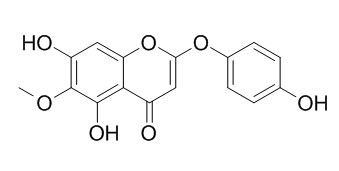Natural Products
Capillarisin
| Catalog No. | CFN90317 |  |
| CAS No. | 56365-38-9 | |
| Molecular Weight: | 316.26 | |
| Molecular Formula | C16H12O7 | |
| DBs | [PubChem]:274954902 [ChEMBL]:3368 [PCIDB]:2420 |
Standard InChI:
InChI=1S/C16H12O7/c1-21-16-11(19)6-12-14(15(16)20)10(18)7-13(23-12)22-9-4-2-8(17)3-5-9/h2-7,17,19-20H,1H3
Biological Activity
Capillarisin is a novel blocker of STAT3 activation, can inhibit constitutive and inducible STAT3 activation through induction of SHP-1 and SHP-2 tyrosine phosphatases, thus it may have a potential in negative regulation of growth, metastasis, and chemoresistance of tumor cells.[1]
Capillarisin suppresses PMA-induced MMP-9 expression through inhibition of the NF-κB-dependent transcriptional activity of MMP-9 gene via p38 MAPK and JNK signaling pathways; capillarisin has no effect on enzymatic activity of MMP-9 and expression of tissue inhibitor of metalloproteinases (TIMP)-1 and TIMP-2, the major endogenous inhibitors of MMPs; suggests that capillarisin represents a potential anti-metastatic agent suppressing cancer cell invasion through specific inhibition of NF-κB-dependent MMP-9 gene expression.[2]
Capillarisin has protective effects on tert-butylhydroperoxide-induced oxidative damage in rat primary hepatocytes.[3]
Capillarisin function as an antioxidant reduced hepatocyte injury caused by hydrophobic bile acids, perhaps by preventing generation of ROS and release of cytochrome c, thereby minimizing hepatocytes apoptosis; capillarisin has inhibition of in vitro growth of hepatoma cells.[4,5]
Capillarisin inhibits proinflammatory cytokines, iNOS, and COX-2, which is attributed to the suppression of LPS-induced ERK, JNK, and nuclear factor-κB (NF-κB) activation, therefore, CPS potentially inhibits the biomarkers related to inflammation through the abrogation of ERK, JNK, and NF-κB p65 activation, and it may be a potential therapeutic candidate for the treatment of inflammatory diseases.[6]
Capillarisin has anti-hyperalgesic and anti-allodynic activities via suppression of inflammatory signaling in animal model.[7]
Product
References
[1] Lee J H, Shu Y C, Nam D, et al. Cancer Lett, 2014, 345(1):140-8.
[2] Lee S O, Jeong Y J, Kim M, et al. Biochem Bioph Res Co, 2008, 366(4):1019-24.
[3] Chu C Y, Tseng T H, Hwang J M, et al. Archive Für Toxikologie, 1999, 73(4):263-8.
[4] Yang C C, Lee M R, Hsu S L, et al. J Supercritl Fluid, 2007, 42(1):96-103.
[5] Lee T Y, Chen F Y, Chang H H, et al. Mol Cell Biochem, 2009, 325(1-2):53-9.
[6] Han S, Lee J H, Kim C, et al. Immunopharm Immunot, 2013, 35(1):34-42.
[7] Khan S, Shehzad O, Chun J, et al. J Ethnopharmacol, 2014, 152(3):478-86.
[8] Chen F X. Strait Pharmaceutical Journal, 2007, 19(5):44-6.
Product Use Citation





